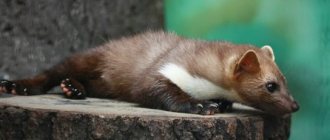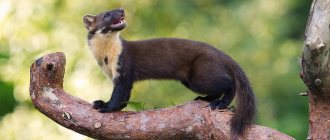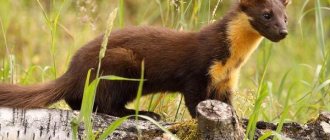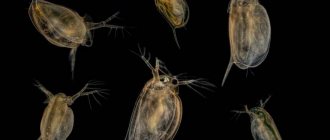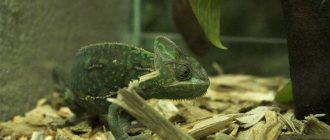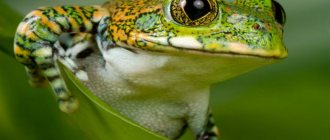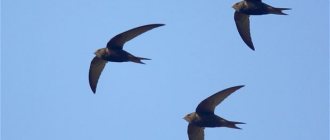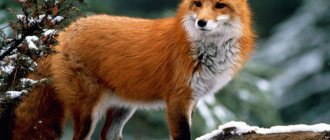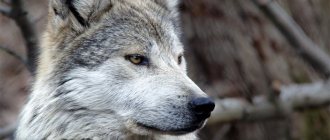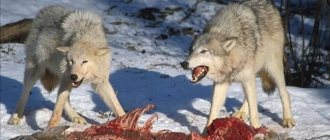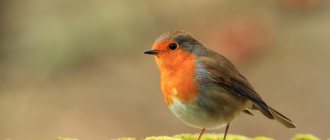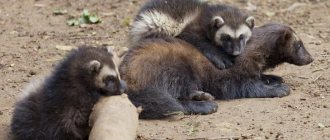The pine marten is a very beautiful and graceful animal, but at the same time it is a bloodthirsty, dexterous and strong predator. Thanks to its sharp claws, well-developed teeth and lightning-fast movements, the animal easily catches squirrels, hunts hare and wood grouse, hazel grouse and black grouse in the darkness of the night.
The marten is a predator that prefers to live in the upper layer of the forest. For her residence, she chooses dark, cluttered spruce forests, which contain an admixture of aspen.
Hunting places
The marten very rarely comes down from the trees to the ground. She prefers to hunt and live in the upper forest layer. However, despite this, her movements on the ground are just as fast and free. The animal is able to run very quickly from one tree trunk to another.
The marten is a very dexterous and incredibly nimble predator. She has a flexible, thin body and a small, flat skull. The animal easily penetrates into narrow crevices between tree trunks and into hollows.
Social structure and reproduction
Photo: Marten
The rutting season for pine martens begins from late June to early August. Pregnancy lasts about 9 months, and cubs are born in the spring from 3 to 5 individuals. Initially, the female stays in the hollow with her brood all the time; after a month and a half, she begins to feed meat, when the milk teeth erupt, and after a month they climb trees.
In sables, the mating season is similar, but usually 2-3 babies are born. Males are very responsible towards the family and do not leave the females after the birth of offspring, protecting the territory and obtaining food. Small sables feed on milk for up to two months, and after two years they themselves start families.
Kidas look deprived in terms of creating families. It so happens that as a result of hybridization, males lose the opportunity to reproduce. They also don’t form flocks like harzas, which is why they are quite logically called loners.
Stone martens are very similar in social structure to forest martens. In the same way, relationships between females and males are built, pregnancy takes place and cubs are raised. In the wild, they live on average 3 years, the luckier or more successful ones - up to 10. In captivity, they often live up to 18 years.
Kharzas, despite their more collective activity, quickly separate after mating. The offspring lives with the mother until the next one appears, after which it leaves her. But often brothers and sisters stick together, which helps them survive in the harsh nature. When individuals become more independent, they separate.
When does a predator prefer to hunt?
Most often, the marten attacks its victims in the evening or night hours. This feature is so characteristic of the described animal that in places where it lives together with the sable, hunters can easily distinguish between their tracks. They believe that only the marten could make night movements. Moreover, the tracks left during the day belong to the sable. However, there are exceptions. Thus, female martens often go out hunting during the day during periods when they are feeding their young. With the onset of winter, if food is plentiful, the predator can rarely be seen outside its cozy shelter. In snowstorms and winter frosts, the marten prefers to sit out in a cozy nest for several days.
The hunting behavior of the predator is very similar to that of the sable. Depending on the amount of food in its habitat, the animal can travel from one to twenty kilometers in a day. The marten lays out especially long hunting routes in crooked forests located in the northern regions of the forest zone. The daily path of a predator is a multiple alternation of loops that lead from one zone of probable food occurrence to another. After the predator is completely satiated, it lies down to rest not far from the place of its feast. In this case, the animal can hide under a log or dead wood, and also climb into the nearest hollow of a bird or squirrel.
Origin of the species and description
Photo: Marten
The question of the origin of martens is complex and mysterious. To do this, it was necessary to conduct a whole detective investigation, determining the identity of all existing species:
- Sable.
- Pine marten.
- Stone marten.
- Ussuri marten (harza).
- Kidus (a mixture of sable and pine marten).
These species belong to the genus of martens and are close relatives of the genus of minks, weasels, rodents, wolverines, ferrets, bandages, badgers, even sea and river otters. These animals have adapted well to life on all continents where people live freely. You can meet them in the Taiga, Europe, Africa, South and North America, and indeed everywhere.
They descended from a common ancestor who may have lived 35 million years ago. The above species belong to the mustelid family and are related to the family of dogs, raccoons, bears and cats. It’s hard to imagine, but they really were similar to each other, because they represented a group of predators.
More mysterious is the common ancestor of the miacids, which inhabited planet Earth about 50 million years ago! It is believed to be the forefather of all known mammalian predators. He was small, flexible, with a long tail and a large brain, which indicates superior intelligence at that time. After 15 million years, some representatives began to acquire the characteristics of martens, and from that moment their history began.
The basis of the diet
What does the marten eat in its habitat? The main food in its diet is voles. The predator eats them not only during the warm season. The animal also catches voles in winter. Moreover, in the winter diet of the predator, their number decreases only by insignificant percentages. This indicates the fact that even a meter thick snow cover is not a serious obstacle for the marten when pursuing its victims. In those years when there are especially many voles, the forest predator is the most well-fed. At the same time, its daily range is reduced to a minimum.
Eagle
This is a spiritual totem, its energy helps to create and heal.
The eagle teaches how, while soaring in the clouds, not to lose touch with the earth and achieve your goals. The Eagle encourages you to use your creativity to achieve your goal, not to be afraid of difficulties and pain along the way, to be in touch with your emotions, especially with the inner child, which gives spiritual purity.
The eagle totem often opens clairvoyance. Eagles mate for life and share marital responsibilities equally. The eagle totem encourages you to take responsibility for your strength.
Second place in diet
What does the marten eat when there are not enough voles in its habitat? During such periods, she begins to hunt for grouse birds. Thus, partridge, black grouse and hazel grouse occupy second place in the animal’s diet. And here the predator has his own preferences. In this group, the hazel grouse plays a predominant role. The marten preys on it in more than fifty percent of cases. There is an explanation for this. The fact is that the hazel grouse lives, as a rule, in the dark coniferous taiga. The marten also chooses these same places for its residence.
It is interesting that grouse are quite rare in the predator’s summer diet. In winter, they make up almost twenty-five percent, because during the cold season they spend most of the day in the snow. At the same time, their hearing and vision are significantly reduced. In such conditions, catching them becomes much easier.
Squirrels as prey
What else does the marten eat? The third place in her winter diet is occupied by proteins. But they are in last place on the summer menu. The predator pursues the red animal, quickly jumping after it along tree branches. If necessary, pursuit continues on the ground. The marten eats squirrels, catching them by surprise at night in hollows or nests. At this time, rodents do not expect attacks.
If the marten’s nutrition is assessed in different years, then one interesting pattern will certainly emerge. It concerns diet. In the event that one or more types of food are missing, the predator updates its diet. Thus, if there are not enough voles, the marten begins to feed on grouse birds, as well as squirrels. This suggests a logical conclusion that the marten is an adaptable predator. The animal does not specialize in any one type of prey. At the same time, he prefers only the food that is most available at the moment. If a large number of voles are bred in a certain year, the predator will feed on them. If there are a lot of hazel grouse, then they will form the basis of his diet.
How much protein can a marten eat during the year?
To answer this question you will need to do a little calculation. The pine marten feeds on one squirrel for two days. Thus, over the entire winter period, a predator can eat up to ninety red animals. However, you should know for sure what the marten eats in the forest in order to make correct calculations.
The marten's diet contains only 19.7 percent protein. Consequently, in winter she eats no more than eighteen rodents. In summer this percentage decreases significantly. During the warm period, squirrels occupy one of the last places in the predator’s diet, amounting to 3.8 percent (three individuals). These calculations allow us to draw clear conclusions. One marten can eat twenty-one squirrels in a year.
However, there are some nuances here too. On average, the weight of the contents of a marten’s stomach is no more than thirty grams. In addition, ongoing studies have shown that ten percent of the digestive tracts of predators are empty at the time of their examination. Consequently, the marten in nature often either partially or completely starves. From this it can be concluded that the previously obtained calculations should be adjusted downward. The marten is capable of eating not twenty-one, but seven to ten squirrels per year.
Swan
One of the most ancient totems. Symbolizes the awakening of inner strength and beauty, which give strength and longevity. Swan women are usually creative individuals, through music and poetry they reveal their inner child and inner strength.
The swan totem comes to awaken emotions and make them more vivid. Helps you realize your true nature, your true beauty. Swan also knows how to see the inner beauty of other people.
Swans are the companions of Aphrodite, the goddess of love and beauty. Swans are strong personalities, devoted parents, and form pairs for life. Often the swan gives the ability to understand other worlds and study energy.
Sweet treat
What does a marten eat? The animal loves honey very much. The predator visits the hollow in which wild bees live until it has completely eaten all the reserves. Near the tree where a wintering bee colony was discovered by a marten, you can see pieces of honeycombs and even the frozen striped workers themselves in the snow. Of course, not every marten finds honey. This is why he is nothing more than a random catch.
If in the summer the pine marten destroys nests built by earth bees or wasps, then as a special delicacy it eats insect larvae with great greed.
Area
The optimal conditions for the existence of the pine marten, in which it feels most comfortable, are oak, spruce, and fir mature forests, tall-trunked, hollow, with dense thickets of dead wood. But its range is by no means limited to such territories.
Yellowfly can be found:
- in Western Siberia;
- in the Northern Urals;
- in forests of Western Europe;
- in the area of alpine meadows;
- in Scotland;
- in the Caucasus and other regions of Western Asia;
- in the Mediterranean (Sicily, Majorca, Corsica, etc.).
The animal does not like areas abounding in rocky areas, as well as rocky landscapes.
Who else does the marten include in its diet?
Depending on where the animal lives, its menu may consist of a variety of warm-blooded animals, including various birds and mammals. Who does the marten eat? It hunts very successfully small rodents, such as chipmunks, marmots and gophers. She can easily catch a hare.
What does the marten that lives near the pond eat? Its prey includes nutria and muskrats, as well as water rats. When starved of food, the marten can follow the trail of a mink, picking up frogs abandoned by it.
In the hollows of trees, the predator hunts for small birds - tits, nuthatches and woodpeckers. During the hungry period, the marten is indiscriminate in food. When the number of voles is low, it eats shrews. In normal times, she prefers to avoid these rodents because of their unpleasant odor.
The predator adds variety to its protein diet by catching large insects. They can be locusts or dragonflies.
The marten is a very brave animal. There is evidence that the predator can attack roe deer cubs. However, these cases are very rare.
When food becomes scarce in the forest, the marten can approach human habitation. On his farmsteads, she attacks dovecotes and chicken coops. Moreover, when the birds begin to rush about in panic, the animal’s predatory reflex awakens. It forces it to kill prey even when its quantity far exceeds the volume that the marten can consume as food. In orchards, the predator steals pears, plums and ripe cherries. In the garden beds he can eat melons and even carrots.
During a hungry period, the animal often digs through garbage disposals and carries dried fruits from the attics of houses. In winter, the marten hunts city mice and rats. The predator easily penetrates heating networks and basements. He has an excellent memory and the ability to perfectly navigate difficult situations.
Diet of domestic marten
Raising a predator in captivity requires the creation of certain nutritional conditions. Domestic martens should receive meat products. There should be at least seventy percent of them in the animal’s diet. As protein food, the predator can be given horse meat and beef, meat by-products and liver, fish, etc.
The feed mixture should contain milk and low-fat cottage cheese, potatoes and apples, mixed feed and a variety of vitamin supplements. In total, the menu should have from eight to ten components.
